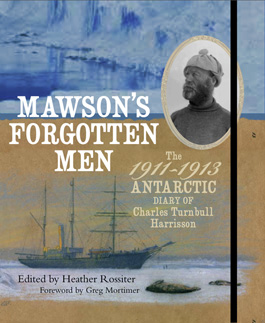Mawson's Forgotten Men The 1911-1913 Antarctic Diary of Charles Turnbull Harrisson Edited by Heather Rossiter

Mawson's Forgotten Men The 1911-1913 Antarctic Diary of Charles Turnbull Harrisson is more than a record of cold and courage; it is a 520-page love letter to his wife Carrie.
Charles Turnbull Harrisson (1867-1914) was the only Tasmanian member of Douglas Mawson's legendary Australasian Antarctic Expedition 1911-14. Appointed biologist and artist to the expedition, Harrisson was a gifted writer. His diary of December 1911 to March 1913 records the challenges that faced the 8-man Western Base party landed on a glacier 2000km west of the Main Base, and their heroic achievements in Queen Mary Land. Transcribed and edited by Heather Rossiter, Harrisson's engaging narrative is complemented by his oil and watercolour paintings, pencil sketches made in the field and many photographs.
In bringing Harrisson's diary from obscure library storage to published volume, Rossiter honours the daring spirit of these lesser known but equally audacious Antarctic explorers.
Reviews
Mawson's Forgotten Men
02/06/2012 Sydney Morning Herald - Spectrum
This beautifully written and evocatively illustrated diary is, perhaps, the most interesting of all the books published so far to celebrate the centenary of Douglas Mawson's Australian Antarctic expedition. It is the work of Charles Turnbull Harisson, a Tasmanian-born biologist and artist who ended up in the expedition's western party stuck on the Shackleton ice shelf for more the a year.
This is not a story about the expedition leaders and their triumphs and troubles. It is a human story, told in the first person, with private and intimate detail, by a man who saw the beauty of the icy land and rejoiced in the opportunity to experience life on the most inhospitable continent on the planet. It is a valuable record of the day-to-day life of one of Mawson's forgotten men, from his departure from Hobart on December 2, 1911, to his return on March 17, 1913.
Workers who kept the records themselves went unrecorded
By Steve Meacham. 02/11/2011 Sydney Morning Herald
IN THE preface to her book Mawson's Forgotten Men, Heather Rossiter laments our fascination with leaders: "As is sadly common with such expeditions, 30 men of the Australian Antarctic Expedition have been overlooked, lost to Antarctic history."
"Only the name of their leader, Mawson, survives in the public memory, yet it was the unremembered men who did the work, went out into the blizzard to read the anemometer, marched inland to record magnetic deviation, who hauled in fish traps and dug through ice to gather rocks that might tell of the land's long history."
Rossiter argues "an emotional need for a hero has led to a reductionist view" of the expedition. "This is not only unfair, it is dishonest."
For this reason, she has edited the 1911-13 Antarctic diary of Charles Turnbull Harrisson, a biologist and artist who was also a gifted writer. Mawson's Forgotten Men, published by Pier 9, focuses on Harrisson's experiences as a member of the Western base party of the Australasian Antarctic Expedition, sent to explore the Shackleton Ice Shelf.
Eight men formed the party: Frank Wild, Harrisson, George Dovers, Charles Hoadley, Sydney Jones, Alexander Kennedy, Morton Moyes and Andrew Watson. Why do so few remember their names?
Stephen Martin, author of A History of Antarctica, has a simple explanation: they were just too damn good. "Nothing went wrong," Martin says. "Nobody died. Nobody got sick. There were no major accidents ... They explored a lot of new land ... They came back with great records. They made great personal friendships, and there were no real animosities.
"The Western base party was incredibly successful and achieved all its goals."
They were led by Wild, who had served with Robert Scott in 1901-04 and with Ernest Shackleton (and Mawson) in 1907-09. Wild was recruited by Mawson to explore lands about 2500 kilometres from the main expedition base. Conditions were terrible and Wild was forced to build his base on floating ice.
Despite that, he and his companions - including the 22-year-old science student Kennedy, who had received special tuition to serve as magnetician - braved dangerous sledging parties to map a vast part of the Queen Mary Land's coast.
Extreme courage was expected of all at both bases. The photographer Frank Hurley, the Kiwi magnetician Eric Webb and the astronomer Edward Frederick "Bob" Bage took part in a heroic 1000-kilometre sledging operation across featureless ice to chart the moving position of the south magnetic pole. On their way back, they had to march on low rations after missing a food depot.
"They nearly got into serious trouble," Martin says. "Hurley wrote a good diary account. It's a remarkable story of man against nature, discovering new land in a really bitter and hostile environment. But it also has human touches - like the sun getting so hot they sometimes had to sledge in their underwear."
Mawson's Forgotten Men
- ISBN:
- 9781742661506
- Published:
- November 2011
- Binding:
- Paperback
- Pages:
- 320 pages
Contact
Publisher and Media enquires
Murdoch Books of Allen & Unwin
enquiries@murdochbooks.com.au
Tel. +61 (2) 8425 0000
Other enquires to